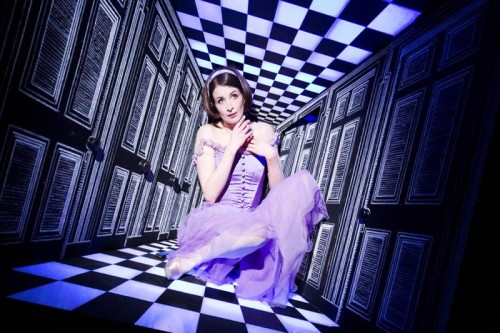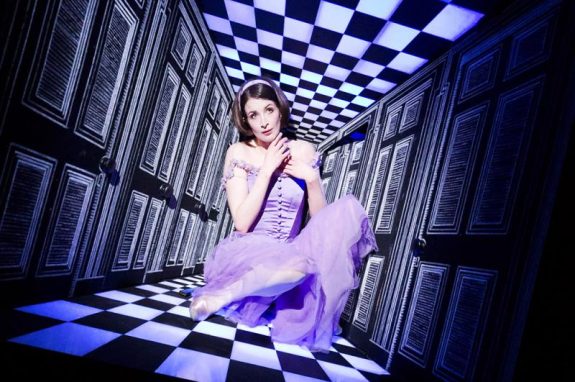 United Kingdom Christopher Wheeldon’s Alice’s Adventures in Wonderland: Soloists, corps de ballet and Royal Opera House Orchestra / Koen Kessels (conductor). Directed for the screen by Ross MacGibbon and broadcast to Cineworld Basildon, Essex, 23.10.2017. (JPr)
United Kingdom Christopher Wheeldon’s Alice’s Adventures in Wonderland: Soloists, corps de ballet and Royal Opera House Orchestra / Koen Kessels (conductor). Directed for the screen by Ross MacGibbon and broadcast to Cineworld Basildon, Essex, 23.10.2017. (JPr)

Cast:
Alice – Lauren Cuthbertson
Jack/The Knave of Hearts – Federico Bonelli
Lewis Carroll/The White Rabbit -James Hay
Mother/The Queen of Hearts -Laura Morera
Magician/The Mad Hatter – Steven McRae
Father/The King of Hearts – Christopher Saunders
The Duchess – Gary Avis
Rajah/The Caterpillar – Fernando Montaño
Vicar/The March Hare – Paul Kay
Verger/The Dormouse – Romany Pajdak
The Cook – Kristen McNally
Fish-Footman – Tristan Dyer
Frog-Footman – David Yudes
Production:
Choreography – Christopher Wheeldon
Staging – Christopher Saunders
Music – Joby Talbot
Orchestration – Christopher Austin and Joby Talbot
Designs – Bob Crowley
Scenario – Nicholas Wright
Lighting design – Natasha Katz
Projection design – Jon Driscoll and Gemma Carrington
Original sound design – Andrew Bruce for Autograph
Live cinema relay introduced by Darcey Bussell and Alexander Campbell
For some schoolchildren it is half-term and before we all head helter-skelter headlong towards Christmas (or Winter Festival if you prefer?) and umpteen performances of The Nutcracker, the Royal Ballet has revived another of their family-friendly ballets, Christopher Wheeldon’s 2011 Alice’s Adventures in Wonderland.
This is a second cinema viewing for me (click here) and while it is possible to reflect on some different dancers, my reaction to this version remains much the same and I apologise if I am tending to repeat my earlier thoughts. To start with I must admit I am not that familiar with the story from the book or film versions, though I understand that Nicholas Wright’s scenario is fairly faithful to the original with some topping and tailing. It begins at Alice’s father’s late-nineteenth century Oxford deanery where we encounter her mean-spirited mother, and all the servants and guests who will become characters in the story Alice probably imagines as an escape from the real world. Lewis Carroll is there reading his stories and taking pictures, and he will transmogrify into the White Rabbit.
I previously described Alice as ‘a drippy teenager’; though she was now – through Lauren Cuthbertson’s superb performance – to be far more independent and a stronger character …and I understand this is how she is in the novel. In the book she is supposed to be about 7, but here she is a teenager on the cusp of puberty. Jack, the gardener, has caught her eye and she attempts to intercede for him when he is sacked having been wrongly accused of stealing a jam tart. Throughout the rest of the ballet Wheeldon just finds ways of bringing Alice and Jack-turned-Knave-of-Hearts back together for some romantic interludes. Alice disappears through Lewis Carroll’s camera bag and the psychedelia begins as she falls – courtesy of some puppetry and wonderful video work from Jon Driscoll and Gemma Carrington – through a time tunnel (that strongly again reminded me of the 1960s’ TV series with that name).
In 2011 Alice’s Adventures in Wonderland was apparently only two acts, but subsequently it was revised into the three-act version it now is. Much as I had even more fun watching it again, it doesn’t deter me from my opinion that it makes the evening too long. There is the Mad Hatter’s tea party (which must be there of course), but the subsequent Rajah/Caterpillar ‘magic mushroom’ scene interlude seems to be from an entirely different evening. The following waltzing and pas de deux for Alice and the Knave in The Garden of Live Flowers – charming as it was – seems mere padding. The worst thing is that you are left thinking where have you seen this choreography before; maybe Scheherazade or La Bayadère and then we get The Nutcracker’s Waltz of the Flowers.
It is the Ashton-inspired character dancers that make Wheeldon’s ballet so worthwhile. The Queen of Hearts (Alice’s mother at the start) – thanks to a gloriously over-the-top performance from Laura Morera – demanded you focus on her every appearance even when merely being wheeled about ‘wearing’ an increasingly huge heart-shaped red ‘dress’. She gets a wonderful parody of The Sleeping Beauty’s famous ‘Rose Adagio’, now involving more jam tarts instead of flowers: it was hilarious and a sublime standout vignette. (There had been another obvious allusion to that famous ballet as Alice and the White Rabbit travel on a huge paper boat made from one of the book’s pages through a forest as in the Panorama.)
Almost all the familiar characters were recognisably present and correct and quite fun to see assuming they didn’t outstay their welcome. Sometimes there is just too much going on, and The Caucus Race, the Sweeney Todd-like sausage-making scene in the Cook’s kitchen, the croquet game and climactic trial scene all suffered from time to time. We don’t really have a ballet, but a dance spectacular in Bob Crowley’s endlessly inventive designs that Wheeldon has directed rather than choreographed. Act III had brought us even more reminiscences, this time with a brooding Nureyev-like adagio solo for the Knave followed by a pastiche of the ‘Balcony Scene’ from Romeo and Juliet (here part Wheeldon, Nureyev and MacMillan).
It is the spectacle that Wheeldon and his collaborators have clearly embraced, with all the magnificent sets, costumes, special effects and splendid visual imagery bringing the story to life. Joby Talbot’s original score is always commendably danceable and – although percussive – allows for some lyrical moments over the three acts amongst all the madcap mayhem. I liked it more on this second hearing, even if at times it now sounded like an homage to Bernard Herrmann’s music for the Hitchcock films. Generally, there was wonderful sound at the Cineworld Basildon and the conductor, Koen Kessels, with an always reliable orchestra, gave a good account of Talbot’s episodic score which was as hard-edged or saccharine as the story demanded.
Darcey Bussell with Alexander Campbell (who danced the White Rabbit in 2014) introduced everything in a relaxed and informative way. (Why is the presentation of these ballet broadcasts so much better than the opera ones?) It was interesting to hear from Simon Russell Beale (who created the role of the Duchess in 2011) and he reminded us that Carroll’s novel is an ‘unwieldly piece to transfer to the stage … always has been’, as well as, praising Wheeldon’s ballet for its coherence and ‘sheer showoffiness’. Beale liked what he has done with Alice’s character because ‘She is a difficult little girl … who has tantrums and you can follow a girl like that.’ In a filmed interview Bob Crowley spoke of how he was inspired by the iconography of Victorian childhood and how the ‘Pig and Pepper is like a nightmare vision of industrial Victorian London’. Speaking of his violet costume for Alice he remarked how he ‘just wanted to dress one of my favourite characters in my favourite colour’ and how for him ‘the colour of love is violet not red’ and that colour, of course, is reserved for the Queen.
What raised this performance to another level was the presence of Lauren Cuthbertson on whom the role of Alice was created in 2011. She was described in one of the projected tweets as ‘an inspiration’ and her performance was indeed inspired. In 2014 I moaned about where was Alice in Wheeldon’s ballet. and in 2017 I realised now Cuthbertson was hardly ever off the stage. She has an impeccable technique, but more significantly, is a captivating dance-actor who creates a totally believable older-than-usual Alice. Her smile never left her face and betrayed the effort ballet’s mechanics requires. Cuthbertson was a compelling stage presence even when required to be manoeuvred when perfectly still (which was a MacMillan trope seen the following evening when she danced in his The Judas Tree).
The Royal Ballet’s dancers were all commendably on great form and in close-up looked much more at ease with Alice’s Adventures than in some of the classics. James Hay as the White Rabbit (Lewis Carroll) wiggled and twitched with neurotic energy. The King of Hearts (Christopher Saunders), The Duchess (Garry Avis), the Cook (Kristen McNally), Fish-Footman (Tristan Dyer), Frog-Footman (David Yudes), Fernando Montaño’s undulating Caterpillar all did well in some of the significant – often scene stealing – smaller roles. Federico Bonelli oozed boyish charm as Jack/the Knave even if he looked occasionally awkward partnering Cuthbertson who was taller than him when en pointe. Also, Steven McRae seemed to have less of the ‘snap, crackle and tap’ as the Mad Hatter that he showed during a filmed demonstration of his tap dancing. But these are minor quibbles for an evening which is at times surreal, always full of fun and fantasy, and thoroughly uplifting.
Jim Pritchard
To view the full list of productions for the 2017/18 season and to find a cinema near you visit http://www.roh.org.uk/cinemas .
